International feminist perspectives
VerifiedAdded on 2022/08/24
|12
|3627
|20
AI Summary
Contribute Materials
Your contribution can guide someone’s learning journey. Share your
documents today.
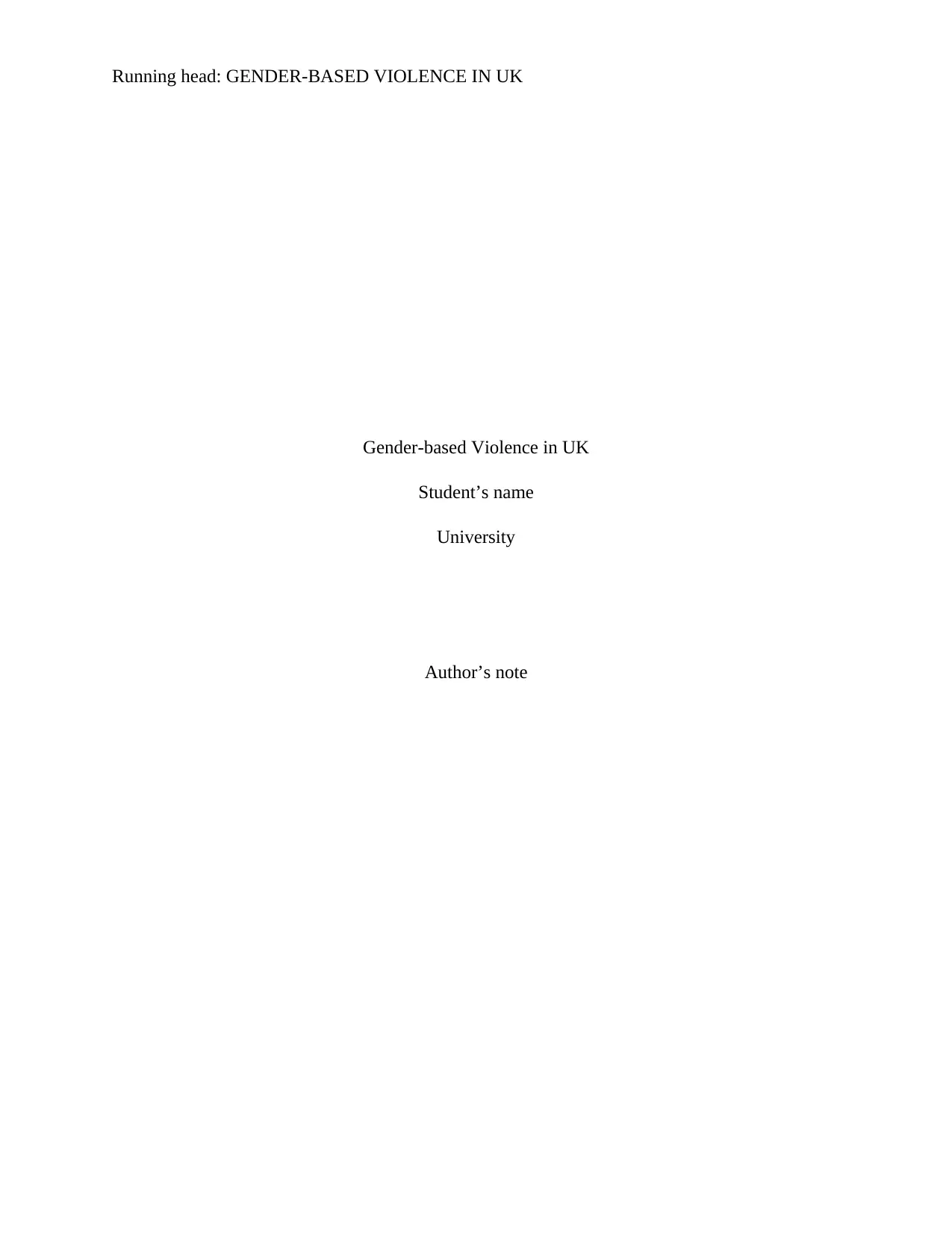
Running head: GENDER-BASED VIOLENCE IN UK
Gender-based Violence in UK
Student’s name
University
Author’s note
Gender-based Violence in UK
Student’s name
University
Author’s note
Secure Best Marks with AI Grader
Need help grading? Try our AI Grader for instant feedback on your assignments.
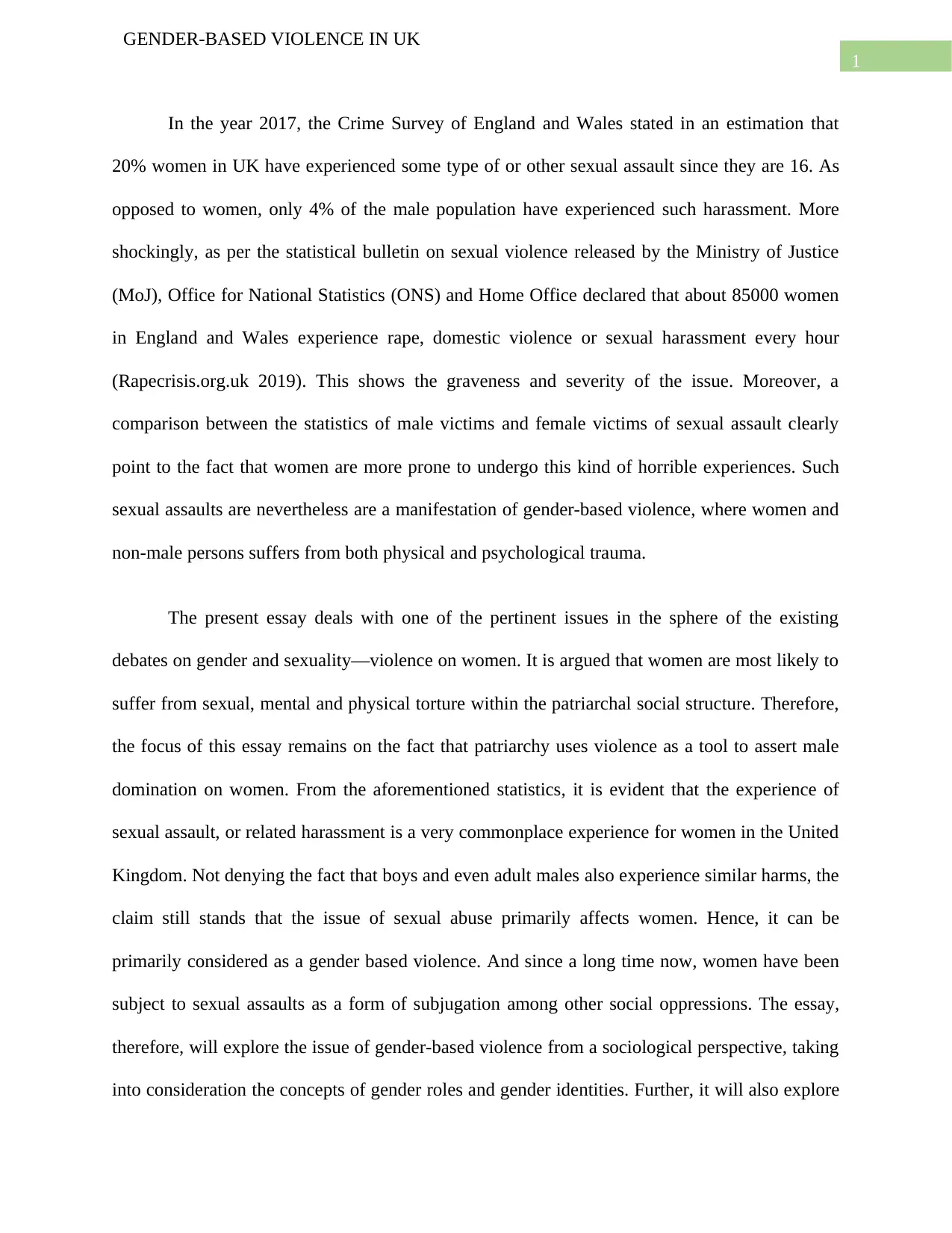
1
GENDER-BASED VIOLENCE IN UK
In the year 2017, the Crime Survey of England and Wales stated in an estimation that
20% women in UK have experienced some type of or other sexual assault since they are 16. As
opposed to women, only 4% of the male population have experienced such harassment. More
shockingly, as per the statistical bulletin on sexual violence released by the Ministry of Justice
(MoJ), Office for National Statistics (ONS) and Home Office declared that about 85000 women
in England and Wales experience rape, domestic violence or sexual harassment every hour
(Rapecrisis.org.uk 2019). This shows the graveness and severity of the issue. Moreover, a
comparison between the statistics of male victims and female victims of sexual assault clearly
point to the fact that women are more prone to undergo this kind of horrible experiences. Such
sexual assaults are nevertheless are a manifestation of gender-based violence, where women and
non-male persons suffers from both physical and psychological trauma.
The present essay deals with one of the pertinent issues in the sphere of the existing
debates on gender and sexuality—violence on women. It is argued that women are most likely to
suffer from sexual, mental and physical torture within the patriarchal social structure. Therefore,
the focus of this essay remains on the fact that patriarchy uses violence as a tool to assert male
domination on women. From the aforementioned statistics, it is evident that the experience of
sexual assault, or related harassment is a very commonplace experience for women in the United
Kingdom. Not denying the fact that boys and even adult males also experience similar harms, the
claim still stands that the issue of sexual abuse primarily affects women. Hence, it can be
primarily considered as a gender based violence. And since a long time now, women have been
subject to sexual assaults as a form of subjugation among other social oppressions. The essay,
therefore, will explore the issue of gender-based violence from a sociological perspective, taking
into consideration the concepts of gender roles and gender identities. Further, it will also explore
GENDER-BASED VIOLENCE IN UK
In the year 2017, the Crime Survey of England and Wales stated in an estimation that
20% women in UK have experienced some type of or other sexual assault since they are 16. As
opposed to women, only 4% of the male population have experienced such harassment. More
shockingly, as per the statistical bulletin on sexual violence released by the Ministry of Justice
(MoJ), Office for National Statistics (ONS) and Home Office declared that about 85000 women
in England and Wales experience rape, domestic violence or sexual harassment every hour
(Rapecrisis.org.uk 2019). This shows the graveness and severity of the issue. Moreover, a
comparison between the statistics of male victims and female victims of sexual assault clearly
point to the fact that women are more prone to undergo this kind of horrible experiences. Such
sexual assaults are nevertheless are a manifestation of gender-based violence, where women and
non-male persons suffers from both physical and psychological trauma.
The present essay deals with one of the pertinent issues in the sphere of the existing
debates on gender and sexuality—violence on women. It is argued that women are most likely to
suffer from sexual, mental and physical torture within the patriarchal social structure. Therefore,
the focus of this essay remains on the fact that patriarchy uses violence as a tool to assert male
domination on women. From the aforementioned statistics, it is evident that the experience of
sexual assault, or related harassment is a very commonplace experience for women in the United
Kingdom. Not denying the fact that boys and even adult males also experience similar harms, the
claim still stands that the issue of sexual abuse primarily affects women. Hence, it can be
primarily considered as a gender based violence. And since a long time now, women have been
subject to sexual assaults as a form of subjugation among other social oppressions. The essay,
therefore, will explore the issue of gender-based violence from a sociological perspective, taking
into consideration the concepts of gender roles and gender identities. Further, it will also explore
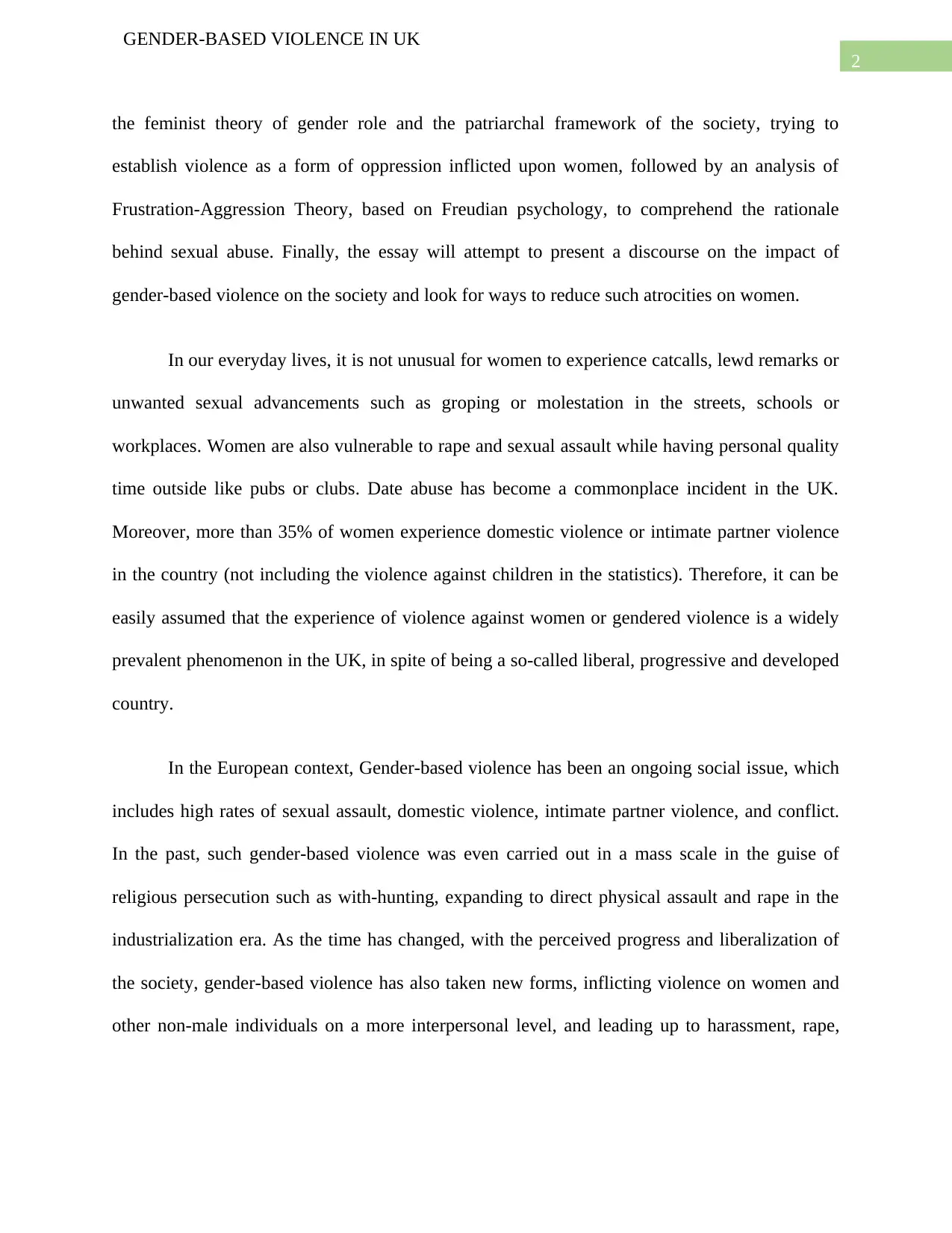
2
GENDER-BASED VIOLENCE IN UK
the feminist theory of gender role and the patriarchal framework of the society, trying to
establish violence as a form of oppression inflicted upon women, followed by an analysis of
Frustration-Aggression Theory, based on Freudian psychology, to comprehend the rationale
behind sexual abuse. Finally, the essay will attempt to present a discourse on the impact of
gender-based violence on the society and look for ways to reduce such atrocities on women.
In our everyday lives, it is not unusual for women to experience catcalls, lewd remarks or
unwanted sexual advancements such as groping or molestation in the streets, schools or
workplaces. Women are also vulnerable to rape and sexual assault while having personal quality
time outside like pubs or clubs. Date abuse has become a commonplace incident in the UK.
Moreover, more than 35% of women experience domestic violence or intimate partner violence
in the country (not including the violence against children in the statistics). Therefore, it can be
easily assumed that the experience of violence against women or gendered violence is a widely
prevalent phenomenon in the UK, in spite of being a so-called liberal, progressive and developed
country.
In the European context, Gender-based violence has been an ongoing social issue, which
includes high rates of sexual assault, domestic violence, intimate partner violence, and conflict.
In the past, such gender-based violence was even carried out in a mass scale in the guise of
religious persecution such as with-hunting, expanding to direct physical assault and rape in the
industrialization era. As the time has changed, with the perceived progress and liberalization of
the society, gender-based violence has also taken new forms, inflicting violence on women and
other non-male individuals on a more interpersonal level, and leading up to harassment, rape,
GENDER-BASED VIOLENCE IN UK
the feminist theory of gender role and the patriarchal framework of the society, trying to
establish violence as a form of oppression inflicted upon women, followed by an analysis of
Frustration-Aggression Theory, based on Freudian psychology, to comprehend the rationale
behind sexual abuse. Finally, the essay will attempt to present a discourse on the impact of
gender-based violence on the society and look for ways to reduce such atrocities on women.
In our everyday lives, it is not unusual for women to experience catcalls, lewd remarks or
unwanted sexual advancements such as groping or molestation in the streets, schools or
workplaces. Women are also vulnerable to rape and sexual assault while having personal quality
time outside like pubs or clubs. Date abuse has become a commonplace incident in the UK.
Moreover, more than 35% of women experience domestic violence or intimate partner violence
in the country (not including the violence against children in the statistics). Therefore, it can be
easily assumed that the experience of violence against women or gendered violence is a widely
prevalent phenomenon in the UK, in spite of being a so-called liberal, progressive and developed
country.
In the European context, Gender-based violence has been an ongoing social issue, which
includes high rates of sexual assault, domestic violence, intimate partner violence, and conflict.
In the past, such gender-based violence was even carried out in a mass scale in the guise of
religious persecution such as with-hunting, expanding to direct physical assault and rape in the
industrialization era. As the time has changed, with the perceived progress and liberalization of
the society, gender-based violence has also taken new forms, inflicting violence on women and
other non-male individuals on a more interpersonal level, and leading up to harassment, rape,
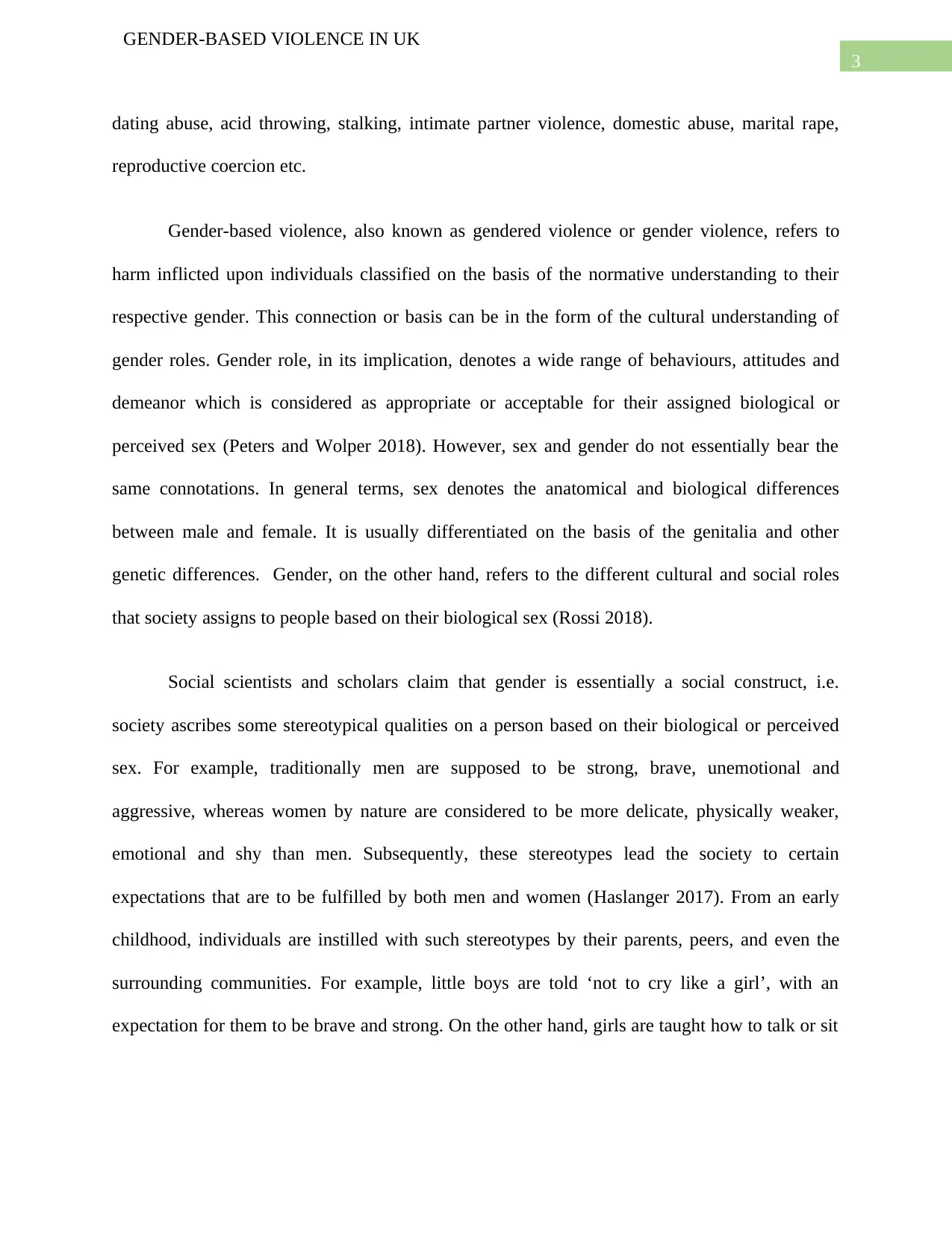
3
GENDER-BASED VIOLENCE IN UK
dating abuse, acid throwing, stalking, intimate partner violence, domestic abuse, marital rape,
reproductive coercion etc.
Gender-based violence, also known as gendered violence or gender violence, refers to
harm inflicted upon individuals classified on the basis of the normative understanding to their
respective gender. This connection or basis can be in the form of the cultural understanding of
gender roles. Gender role, in its implication, denotes a wide range of behaviours, attitudes and
demeanor which is considered as appropriate or acceptable for their assigned biological or
perceived sex (Peters and Wolper 2018). However, sex and gender do not essentially bear the
same connotations. In general terms, sex denotes the anatomical and biological differences
between male and female. It is usually differentiated on the basis of the genitalia and other
genetic differences. Gender, on the other hand, refers to the different cultural and social roles
that society assigns to people based on their biological sex (Rossi 2018).
Social scientists and scholars claim that gender is essentially a social construct, i.e.
society ascribes some stereotypical qualities on a person based on their biological or perceived
sex. For example, traditionally men are supposed to be strong, brave, unemotional and
aggressive, whereas women by nature are considered to be more delicate, physically weaker,
emotional and shy than men. Subsequently, these stereotypes lead the society to certain
expectations that are to be fulfilled by both men and women (Haslanger 2017). From an early
childhood, individuals are instilled with such stereotypes by their parents, peers, and even the
surrounding communities. For example, little boys are told ‘not to cry like a girl’, with an
expectation for them to be brave and strong. On the other hand, girls are taught how to talk or sit
GENDER-BASED VIOLENCE IN UK
dating abuse, acid throwing, stalking, intimate partner violence, domestic abuse, marital rape,
reproductive coercion etc.
Gender-based violence, also known as gendered violence or gender violence, refers to
harm inflicted upon individuals classified on the basis of the normative understanding to their
respective gender. This connection or basis can be in the form of the cultural understanding of
gender roles. Gender role, in its implication, denotes a wide range of behaviours, attitudes and
demeanor which is considered as appropriate or acceptable for their assigned biological or
perceived sex (Peters and Wolper 2018). However, sex and gender do not essentially bear the
same connotations. In general terms, sex denotes the anatomical and biological differences
between male and female. It is usually differentiated on the basis of the genitalia and other
genetic differences. Gender, on the other hand, refers to the different cultural and social roles
that society assigns to people based on their biological sex (Rossi 2018).
Social scientists and scholars claim that gender is essentially a social construct, i.e.
society ascribes some stereotypical qualities on a person based on their biological or perceived
sex. For example, traditionally men are supposed to be strong, brave, unemotional and
aggressive, whereas women by nature are considered to be more delicate, physically weaker,
emotional and shy than men. Subsequently, these stereotypes lead the society to certain
expectations that are to be fulfilled by both men and women (Haslanger 2017). From an early
childhood, individuals are instilled with such stereotypes by their parents, peers, and even the
surrounding communities. For example, little boys are told ‘not to cry like a girl’, with an
expectation for them to be brave and strong. On the other hand, girls are taught how to talk or sit
Secure Best Marks with AI Grader
Need help grading? Try our AI Grader for instant feedback on your assignments.
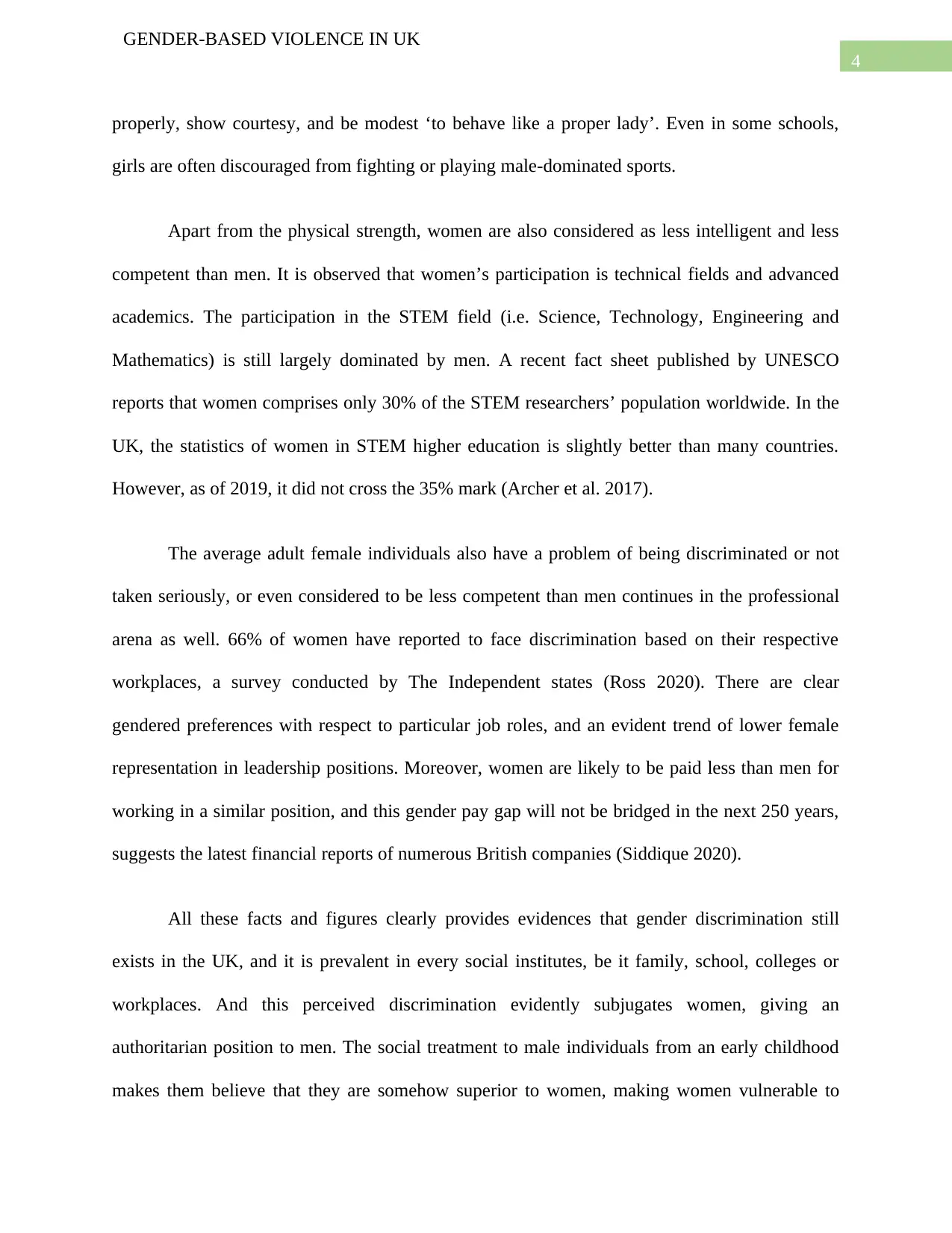
4
GENDER-BASED VIOLENCE IN UK
properly, show courtesy, and be modest ‘to behave like a proper lady’. Even in some schools,
girls are often discouraged from fighting or playing male-dominated sports.
Apart from the physical strength, women are also considered as less intelligent and less
competent than men. It is observed that women’s participation is technical fields and advanced
academics. The participation in the STEM field (i.e. Science, Technology, Engineering and
Mathematics) is still largely dominated by men. A recent fact sheet published by UNESCO
reports that women comprises only 30% of the STEM researchers’ population worldwide. In the
UK, the statistics of women in STEM higher education is slightly better than many countries.
However, as of 2019, it did not cross the 35% mark (Archer et al. 2017).
The average adult female individuals also have a problem of being discriminated or not
taken seriously, or even considered to be less competent than men continues in the professional
arena as well. 66% of women have reported to face discrimination based on their respective
workplaces, a survey conducted by The Independent states (Ross 2020). There are clear
gendered preferences with respect to particular job roles, and an evident trend of lower female
representation in leadership positions. Moreover, women are likely to be paid less than men for
working in a similar position, and this gender pay gap will not be bridged in the next 250 years,
suggests the latest financial reports of numerous British companies (Siddique 2020).
All these facts and figures clearly provides evidences that gender discrimination still
exists in the UK, and it is prevalent in every social institutes, be it family, school, colleges or
workplaces. And this perceived discrimination evidently subjugates women, giving an
authoritarian position to men. The social treatment to male individuals from an early childhood
makes them believe that they are somehow superior to women, making women vulnerable to
GENDER-BASED VIOLENCE IN UK
properly, show courtesy, and be modest ‘to behave like a proper lady’. Even in some schools,
girls are often discouraged from fighting or playing male-dominated sports.
Apart from the physical strength, women are also considered as less intelligent and less
competent than men. It is observed that women’s participation is technical fields and advanced
academics. The participation in the STEM field (i.e. Science, Technology, Engineering and
Mathematics) is still largely dominated by men. A recent fact sheet published by UNESCO
reports that women comprises only 30% of the STEM researchers’ population worldwide. In the
UK, the statistics of women in STEM higher education is slightly better than many countries.
However, as of 2019, it did not cross the 35% mark (Archer et al. 2017).
The average adult female individuals also have a problem of being discriminated or not
taken seriously, or even considered to be less competent than men continues in the professional
arena as well. 66% of women have reported to face discrimination based on their respective
workplaces, a survey conducted by The Independent states (Ross 2020). There are clear
gendered preferences with respect to particular job roles, and an evident trend of lower female
representation in leadership positions. Moreover, women are likely to be paid less than men for
working in a similar position, and this gender pay gap will not be bridged in the next 250 years,
suggests the latest financial reports of numerous British companies (Siddique 2020).
All these facts and figures clearly provides evidences that gender discrimination still
exists in the UK, and it is prevalent in every social institutes, be it family, school, colleges or
workplaces. And this perceived discrimination evidently subjugates women, giving an
authoritarian position to men. The social treatment to male individuals from an early childhood
makes them believe that they are somehow superior to women, making women vulnerable to
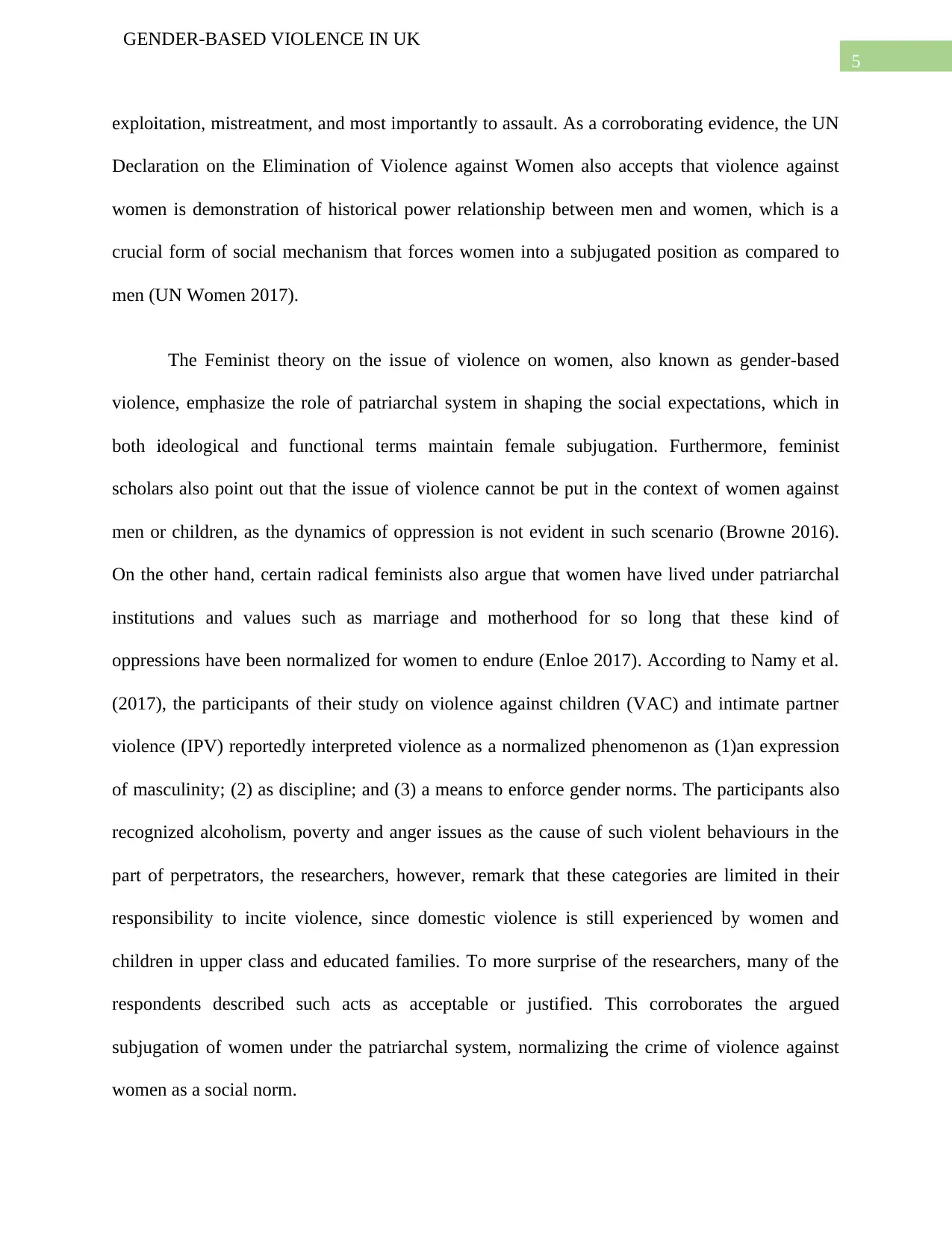
5
GENDER-BASED VIOLENCE IN UK
exploitation, mistreatment, and most importantly to assault. As a corroborating evidence, the UN
Declaration on the Elimination of Violence against Women also accepts that violence against
women is demonstration of historical power relationship between men and women, which is a
crucial form of social mechanism that forces women into a subjugated position as compared to
men (UN Women 2017).
The Feminist theory on the issue of violence on women, also known as gender-based
violence, emphasize the role of patriarchal system in shaping the social expectations, which in
both ideological and functional terms maintain female subjugation. Furthermore, feminist
scholars also point out that the issue of violence cannot be put in the context of women against
men or children, as the dynamics of oppression is not evident in such scenario (Browne 2016).
On the other hand, certain radical feminists also argue that women have lived under patriarchal
institutions and values such as marriage and motherhood for so long that these kind of
oppressions have been normalized for women to endure (Enloe 2017). According to Namy et al.
(2017), the participants of their study on violence against children (VAC) and intimate partner
violence (IPV) reportedly interpreted violence as a normalized phenomenon as (1)an expression
of masculinity; (2) as discipline; and (3) a means to enforce gender norms. The participants also
recognized alcoholism, poverty and anger issues as the cause of such violent behaviours in the
part of perpetrators, the researchers, however, remark that these categories are limited in their
responsibility to incite violence, since domestic violence is still experienced by women and
children in upper class and educated families. To more surprise of the researchers, many of the
respondents described such acts as acceptable or justified. This corroborates the argued
subjugation of women under the patriarchal system, normalizing the crime of violence against
women as a social norm.
GENDER-BASED VIOLENCE IN UK
exploitation, mistreatment, and most importantly to assault. As a corroborating evidence, the UN
Declaration on the Elimination of Violence against Women also accepts that violence against
women is demonstration of historical power relationship between men and women, which is a
crucial form of social mechanism that forces women into a subjugated position as compared to
men (UN Women 2017).
The Feminist theory on the issue of violence on women, also known as gender-based
violence, emphasize the role of patriarchal system in shaping the social expectations, which in
both ideological and functional terms maintain female subjugation. Furthermore, feminist
scholars also point out that the issue of violence cannot be put in the context of women against
men or children, as the dynamics of oppression is not evident in such scenario (Browne 2016).
On the other hand, certain radical feminists also argue that women have lived under patriarchal
institutions and values such as marriage and motherhood for so long that these kind of
oppressions have been normalized for women to endure (Enloe 2017). According to Namy et al.
(2017), the participants of their study on violence against children (VAC) and intimate partner
violence (IPV) reportedly interpreted violence as a normalized phenomenon as (1)an expression
of masculinity; (2) as discipline; and (3) a means to enforce gender norms. The participants also
recognized alcoholism, poverty and anger issues as the cause of such violent behaviours in the
part of perpetrators, the researchers, however, remark that these categories are limited in their
responsibility to incite violence, since domestic violence is still experienced by women and
children in upper class and educated families. To more surprise of the researchers, many of the
respondents described such acts as acceptable or justified. This corroborates the argued
subjugation of women under the patriarchal system, normalizing the crime of violence against
women as a social norm.
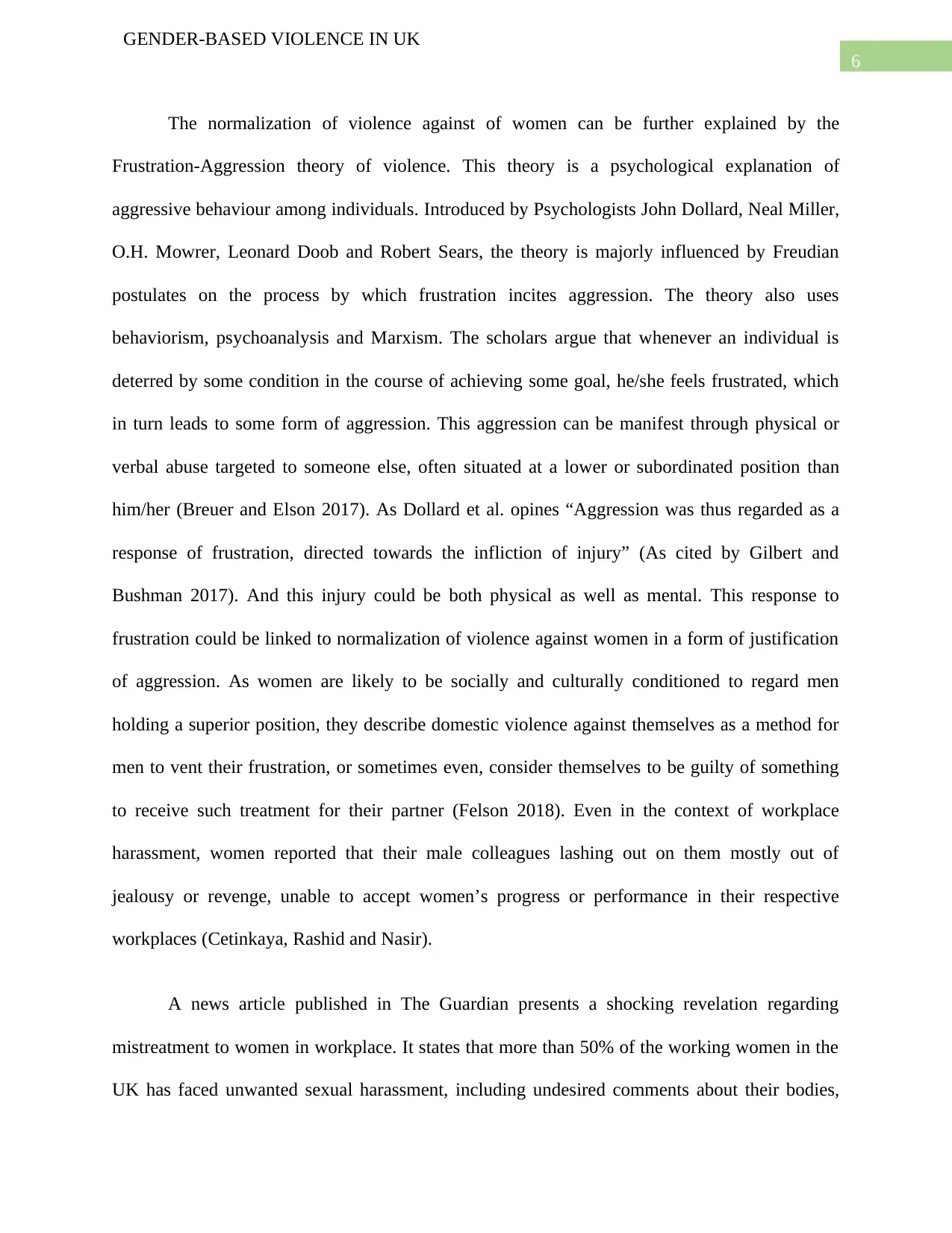
6
GENDER-BASED VIOLENCE IN UK
The normalization of violence against of women can be further explained by the
Frustration-Aggression theory of violence. This theory is a psychological explanation of
aggressive behaviour among individuals. Introduced by Psychologists John Dollard, Neal Miller,
O.H. Mowrer, Leonard Doob and Robert Sears, the theory is majorly influenced by Freudian
postulates on the process by which frustration incites aggression. The theory also uses
behaviorism, psychoanalysis and Marxism. The scholars argue that whenever an individual is
deterred by some condition in the course of achieving some goal, he/she feels frustrated, which
in turn leads to some form of aggression. This aggression can be manifest through physical or
verbal abuse targeted to someone else, often situated at a lower or subordinated position than
him/her (Breuer and Elson 2017). As Dollard et al. opines “Aggression was thus regarded as a
response of frustration, directed towards the infliction of injury” (As cited by Gilbert and
Bushman 2017). And this injury could be both physical as well as mental. This response to
frustration could be linked to normalization of violence against women in a form of justification
of aggression. As women are likely to be socially and culturally conditioned to regard men
holding a superior position, they describe domestic violence against themselves as a method for
men to vent their frustration, or sometimes even, consider themselves to be guilty of something
to receive such treatment for their partner (Felson 2018). Even in the context of workplace
harassment, women reported that their male colleagues lashing out on them mostly out of
jealousy or revenge, unable to accept women’s progress or performance in their respective
workplaces (Cetinkaya, Rashid and Nasir).
A news article published in The Guardian presents a shocking revelation regarding
mistreatment to women in workplace. It states that more than 50% of the working women in the
UK has faced unwanted sexual harassment, including undesired comments about their bodies,
GENDER-BASED VIOLENCE IN UK
The normalization of violence against of women can be further explained by the
Frustration-Aggression theory of violence. This theory is a psychological explanation of
aggressive behaviour among individuals. Introduced by Psychologists John Dollard, Neal Miller,
O.H. Mowrer, Leonard Doob and Robert Sears, the theory is majorly influenced by Freudian
postulates on the process by which frustration incites aggression. The theory also uses
behaviorism, psychoanalysis and Marxism. The scholars argue that whenever an individual is
deterred by some condition in the course of achieving some goal, he/she feels frustrated, which
in turn leads to some form of aggression. This aggression can be manifest through physical or
verbal abuse targeted to someone else, often situated at a lower or subordinated position than
him/her (Breuer and Elson 2017). As Dollard et al. opines “Aggression was thus regarded as a
response of frustration, directed towards the infliction of injury” (As cited by Gilbert and
Bushman 2017). And this injury could be both physical as well as mental. This response to
frustration could be linked to normalization of violence against women in a form of justification
of aggression. As women are likely to be socially and culturally conditioned to regard men
holding a superior position, they describe domestic violence against themselves as a method for
men to vent their frustration, or sometimes even, consider themselves to be guilty of something
to receive such treatment for their partner (Felson 2018). Even in the context of workplace
harassment, women reported that their male colleagues lashing out on them mostly out of
jealousy or revenge, unable to accept women’s progress or performance in their respective
workplaces (Cetinkaya, Rashid and Nasir).
A news article published in The Guardian presents a shocking revelation regarding
mistreatment to women in workplace. It states that more than 50% of the working women in the
UK has faced unwanted sexual harassment, including undesired comments about their bodies,
Paraphrase This Document
Need a fresh take? Get an instant paraphrase of this document with our AI Paraphraser
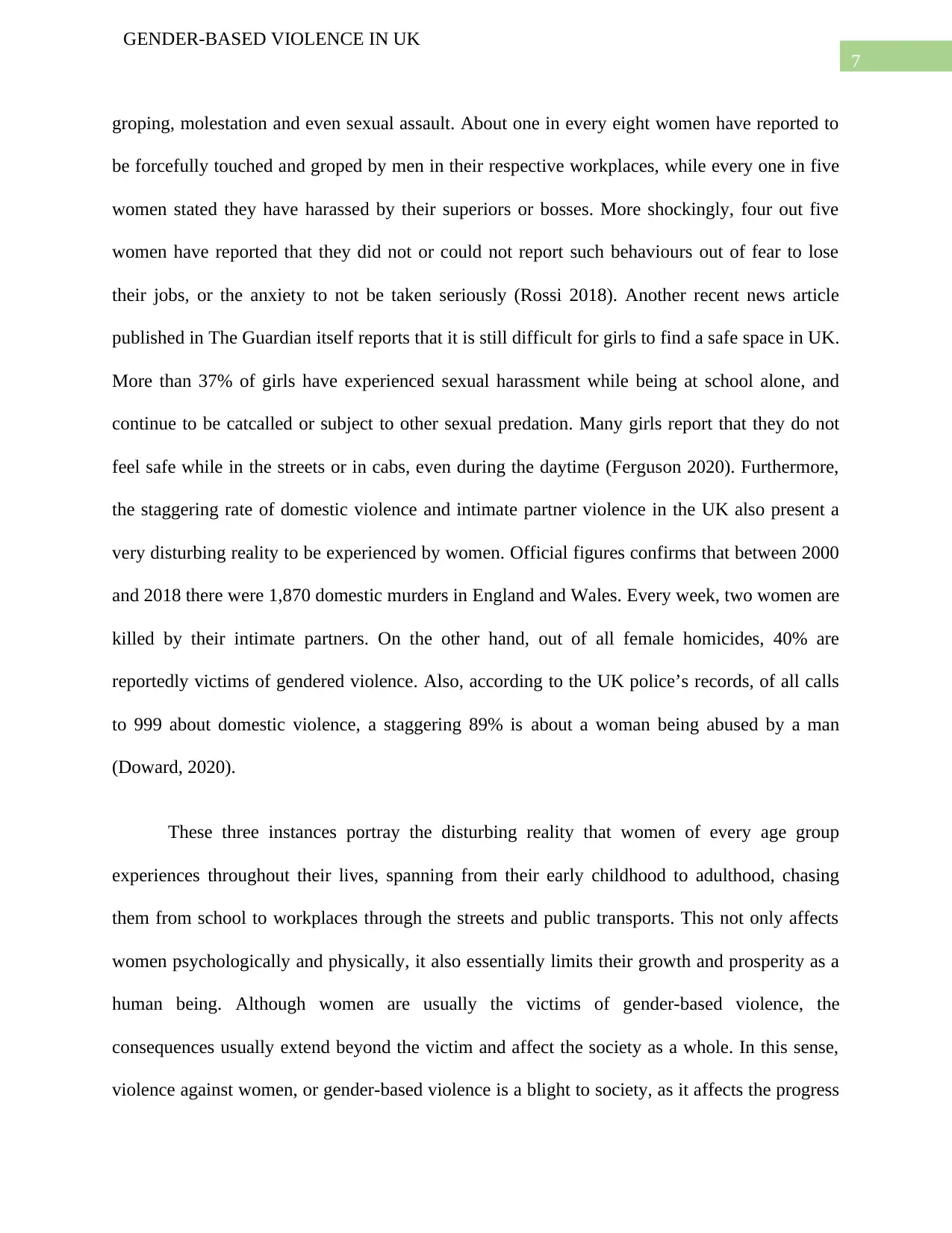
7
GENDER-BASED VIOLENCE IN UK
groping, molestation and even sexual assault. About one in every eight women have reported to
be forcefully touched and groped by men in their respective workplaces, while every one in five
women stated they have harassed by their superiors or bosses. More shockingly, four out five
women have reported that they did not or could not report such behaviours out of fear to lose
their jobs, or the anxiety to not be taken seriously (Rossi 2018). Another recent news article
published in The Guardian itself reports that it is still difficult for girls to find a safe space in UK.
More than 37% of girls have experienced sexual harassment while being at school alone, and
continue to be catcalled or subject to other sexual predation. Many girls report that they do not
feel safe while in the streets or in cabs, even during the daytime (Ferguson 2020). Furthermore,
the staggering rate of domestic violence and intimate partner violence in the UK also present a
very disturbing reality to be experienced by women. Official figures confirms that between 2000
and 2018 there were 1,870 domestic murders in England and Wales. Every week, two women are
killed by their intimate partners. On the other hand, out of all female homicides, 40% are
reportedly victims of gendered violence. Also, according to the UK police’s records, of all calls
to 999 about domestic violence, a staggering 89% is about a woman being abused by a man
(Doward, 2020).
These three instances portray the disturbing reality that women of every age group
experiences throughout their lives, spanning from their early childhood to adulthood, chasing
them from school to workplaces through the streets and public transports. This not only affects
women psychologically and physically, it also essentially limits their growth and prosperity as a
human being. Although women are usually the victims of gender-based violence, the
consequences usually extend beyond the victim and affect the society as a whole. In this sense,
violence against women, or gender-based violence is a blight to society, as it affects the progress
GENDER-BASED VIOLENCE IN UK
groping, molestation and even sexual assault. About one in every eight women have reported to
be forcefully touched and groped by men in their respective workplaces, while every one in five
women stated they have harassed by their superiors or bosses. More shockingly, four out five
women have reported that they did not or could not report such behaviours out of fear to lose
their jobs, or the anxiety to not be taken seriously (Rossi 2018). Another recent news article
published in The Guardian itself reports that it is still difficult for girls to find a safe space in UK.
More than 37% of girls have experienced sexual harassment while being at school alone, and
continue to be catcalled or subject to other sexual predation. Many girls report that they do not
feel safe while in the streets or in cabs, even during the daytime (Ferguson 2020). Furthermore,
the staggering rate of domestic violence and intimate partner violence in the UK also present a
very disturbing reality to be experienced by women. Official figures confirms that between 2000
and 2018 there were 1,870 domestic murders in England and Wales. Every week, two women are
killed by their intimate partners. On the other hand, out of all female homicides, 40% are
reportedly victims of gendered violence. Also, according to the UK police’s records, of all calls
to 999 about domestic violence, a staggering 89% is about a woman being abused by a man
(Doward, 2020).
These three instances portray the disturbing reality that women of every age group
experiences throughout their lives, spanning from their early childhood to adulthood, chasing
them from school to workplaces through the streets and public transports. This not only affects
women psychologically and physically, it also essentially limits their growth and prosperity as a
human being. Although women are usually the victims of gender-based violence, the
consequences usually extend beyond the victim and affect the society as a whole. In this sense,
violence against women, or gender-based violence is a blight to society, as it affects the progress
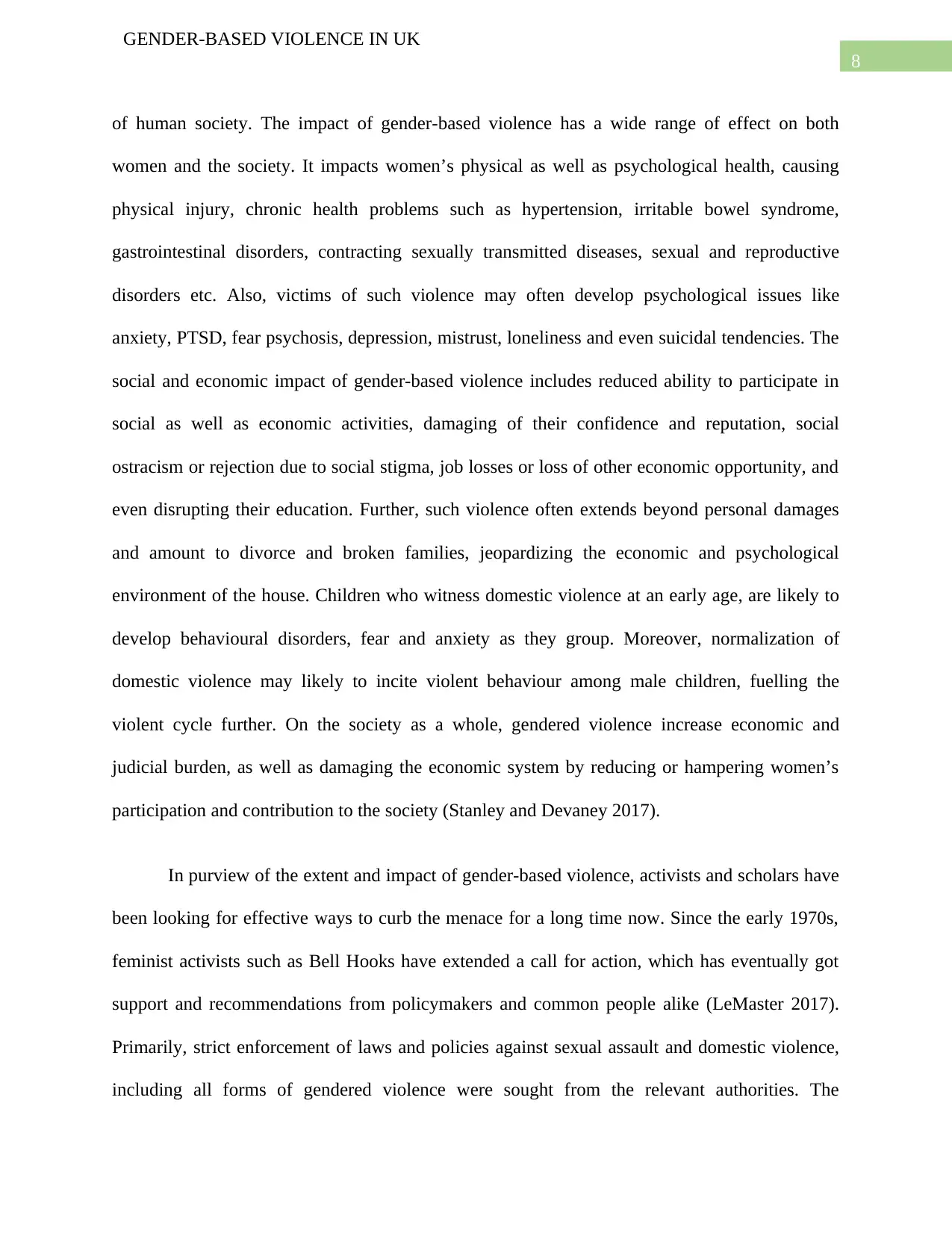
8
GENDER-BASED VIOLENCE IN UK
of human society. The impact of gender-based violence has a wide range of effect on both
women and the society. It impacts women’s physical as well as psychological health, causing
physical injury, chronic health problems such as hypertension, irritable bowel syndrome,
gastrointestinal disorders, contracting sexually transmitted diseases, sexual and reproductive
disorders etc. Also, victims of such violence may often develop psychological issues like
anxiety, PTSD, fear psychosis, depression, mistrust, loneliness and even suicidal tendencies. The
social and economic impact of gender-based violence includes reduced ability to participate in
social as well as economic activities, damaging of their confidence and reputation, social
ostracism or rejection due to social stigma, job losses or loss of other economic opportunity, and
even disrupting their education. Further, such violence often extends beyond personal damages
and amount to divorce and broken families, jeopardizing the economic and psychological
environment of the house. Children who witness domestic violence at an early age, are likely to
develop behavioural disorders, fear and anxiety as they group. Moreover, normalization of
domestic violence may likely to incite violent behaviour among male children, fuelling the
violent cycle further. On the society as a whole, gendered violence increase economic and
judicial burden, as well as damaging the economic system by reducing or hampering women’s
participation and contribution to the society (Stanley and Devaney 2017).
In purview of the extent and impact of gender-based violence, activists and scholars have
been looking for effective ways to curb the menace for a long time now. Since the early 1970s,
feminist activists such as Bell Hooks have extended a call for action, which has eventually got
support and recommendations from policymakers and common people alike (LeMaster 2017).
Primarily, strict enforcement of laws and policies against sexual assault and domestic violence,
including all forms of gendered violence were sought from the relevant authorities. The
GENDER-BASED VIOLENCE IN UK
of human society. The impact of gender-based violence has a wide range of effect on both
women and the society. It impacts women’s physical as well as psychological health, causing
physical injury, chronic health problems such as hypertension, irritable bowel syndrome,
gastrointestinal disorders, contracting sexually transmitted diseases, sexual and reproductive
disorders etc. Also, victims of such violence may often develop psychological issues like
anxiety, PTSD, fear psychosis, depression, mistrust, loneliness and even suicidal tendencies. The
social and economic impact of gender-based violence includes reduced ability to participate in
social as well as economic activities, damaging of their confidence and reputation, social
ostracism or rejection due to social stigma, job losses or loss of other economic opportunity, and
even disrupting their education. Further, such violence often extends beyond personal damages
and amount to divorce and broken families, jeopardizing the economic and psychological
environment of the house. Children who witness domestic violence at an early age, are likely to
develop behavioural disorders, fear and anxiety as they group. Moreover, normalization of
domestic violence may likely to incite violent behaviour among male children, fuelling the
violent cycle further. On the society as a whole, gendered violence increase economic and
judicial burden, as well as damaging the economic system by reducing or hampering women’s
participation and contribution to the society (Stanley and Devaney 2017).
In purview of the extent and impact of gender-based violence, activists and scholars have
been looking for effective ways to curb the menace for a long time now. Since the early 1970s,
feminist activists such as Bell Hooks have extended a call for action, which has eventually got
support and recommendations from policymakers and common people alike (LeMaster 2017).
Primarily, strict enforcement of laws and policies against sexual assault and domestic violence,
including all forms of gendered violence were sought from the relevant authorities. The
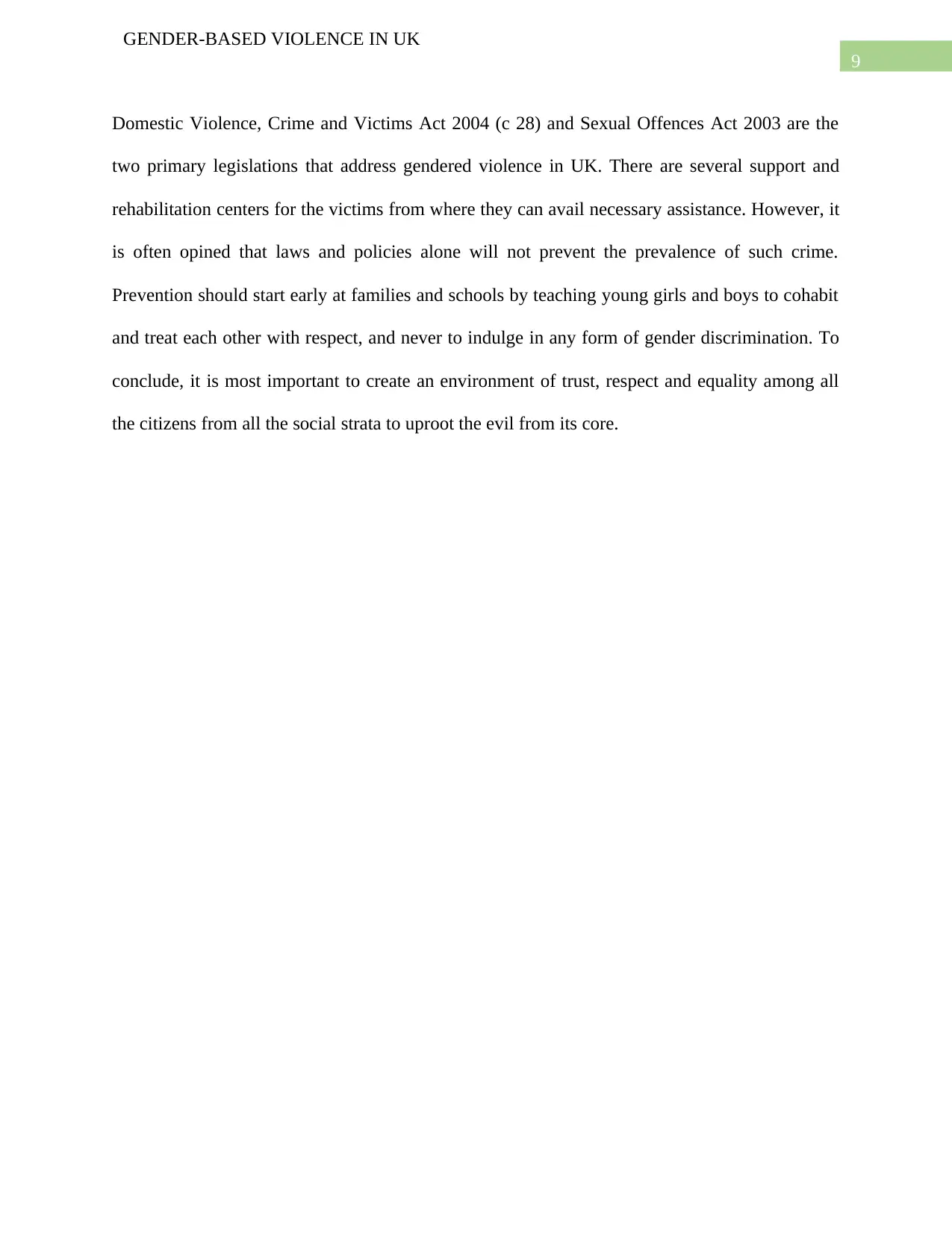
9
GENDER-BASED VIOLENCE IN UK
Domestic Violence, Crime and Victims Act 2004 (c 28) and Sexual Offences Act 2003 are the
two primary legislations that address gendered violence in UK. There are several support and
rehabilitation centers for the victims from where they can avail necessary assistance. However, it
is often opined that laws and policies alone will not prevent the prevalence of such crime.
Prevention should start early at families and schools by teaching young girls and boys to cohabit
and treat each other with respect, and never to indulge in any form of gender discrimination. To
conclude, it is most important to create an environment of trust, respect and equality among all
the citizens from all the social strata to uproot the evil from its core.
GENDER-BASED VIOLENCE IN UK
Domestic Violence, Crime and Victims Act 2004 (c 28) and Sexual Offences Act 2003 are the
two primary legislations that address gendered violence in UK. There are several support and
rehabilitation centers for the victims from where they can avail necessary assistance. However, it
is often opined that laws and policies alone will not prevent the prevalence of such crime.
Prevention should start early at families and schools by teaching young girls and boys to cohabit
and treat each other with respect, and never to indulge in any form of gender discrimination. To
conclude, it is most important to create an environment of trust, respect and equality among all
the citizens from all the social strata to uproot the evil from its core.
Secure Best Marks with AI Grader
Need help grading? Try our AI Grader for instant feedback on your assignments.
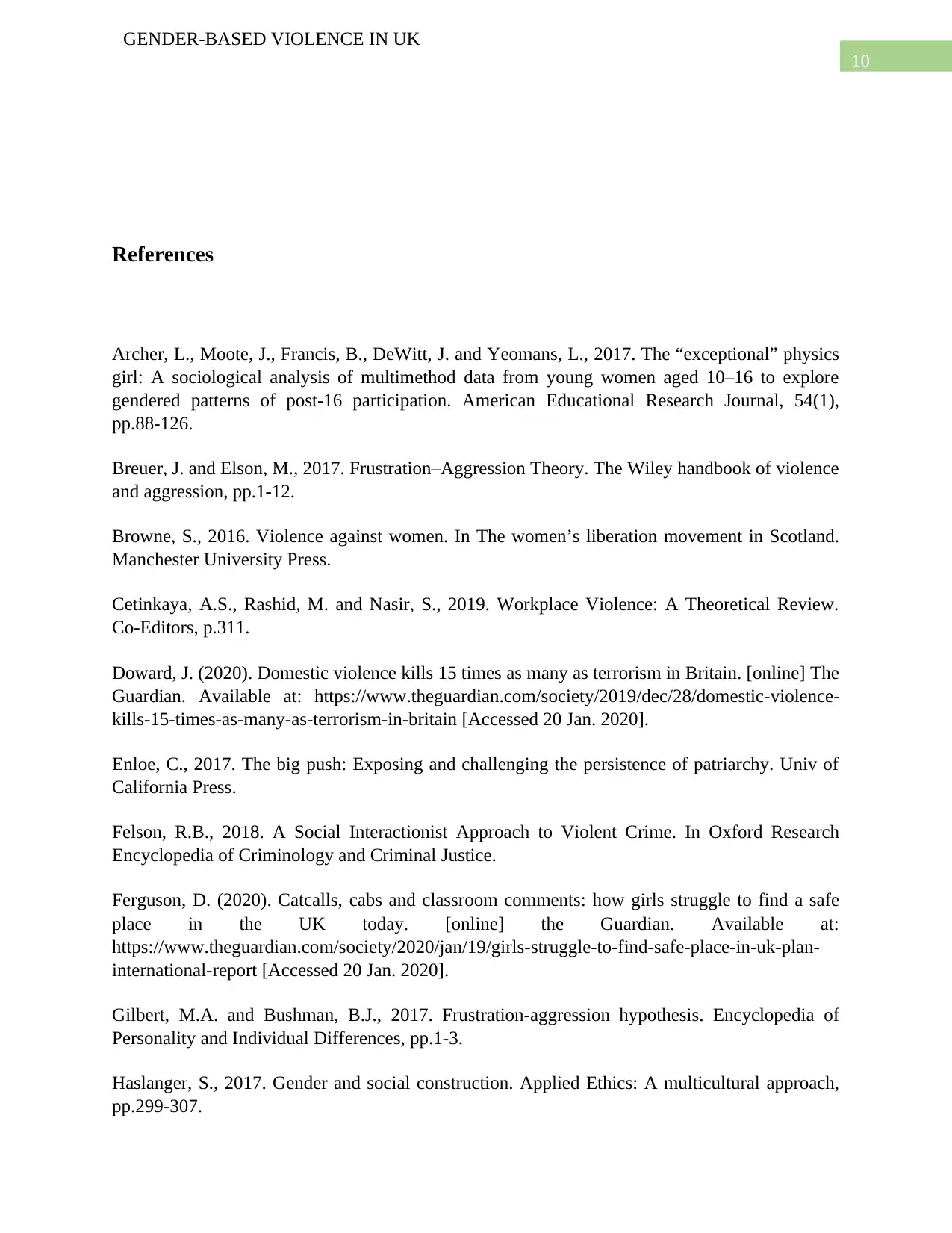
10
GENDER-BASED VIOLENCE IN UK
References
Archer, L., Moote, J., Francis, B., DeWitt, J. and Yeomans, L., 2017. The “exceptional” physics
girl: A sociological analysis of multimethod data from young women aged 10–16 to explore
gendered patterns of post-16 participation. American Educational Research Journal, 54(1),
pp.88-126.
Breuer, J. and Elson, M., 2017. Frustration–Aggression Theory. The Wiley handbook of violence
and aggression, pp.1-12.
Browne, S., 2016. Violence against women. In The women’s liberation movement in Scotland.
Manchester University Press.
Cetinkaya, A.S., Rashid, M. and Nasir, S., 2019. Workplace Violence: A Theoretical Review.
Co-Editors, p.311.
Doward, J. (2020). Domestic violence kills 15 times as many as terrorism in Britain. [online] The
Guardian. Available at: https://www.theguardian.com/society/2019/dec/28/domestic-violence-
kills-15-times-as-many-as-terrorism-in-britain [Accessed 20 Jan. 2020].
Enloe, C., 2017. The big push: Exposing and challenging the persistence of patriarchy. Univ of
California Press.
Felson, R.B., 2018. A Social Interactionist Approach to Violent Crime. In Oxford Research
Encyclopedia of Criminology and Criminal Justice.
Ferguson, D. (2020). Catcalls, cabs and classroom comments: how girls struggle to find a safe
place in the UK today. [online] the Guardian. Available at:
https://www.theguardian.com/society/2020/jan/19/girls-struggle-to-find-safe-place-in-uk-plan-
international-report [Accessed 20 Jan. 2020].
Gilbert, M.A. and Bushman, B.J., 2017. Frustration-aggression hypothesis. Encyclopedia of
Personality and Individual Differences, pp.1-3.
Haslanger, S., 2017. Gender and social construction. Applied Ethics: A multicultural approach,
pp.299-307.
GENDER-BASED VIOLENCE IN UK
References
Archer, L., Moote, J., Francis, B., DeWitt, J. and Yeomans, L., 2017. The “exceptional” physics
girl: A sociological analysis of multimethod data from young women aged 10–16 to explore
gendered patterns of post-16 participation. American Educational Research Journal, 54(1),
pp.88-126.
Breuer, J. and Elson, M., 2017. Frustration–Aggression Theory. The Wiley handbook of violence
and aggression, pp.1-12.
Browne, S., 2016. Violence against women. In The women’s liberation movement in Scotland.
Manchester University Press.
Cetinkaya, A.S., Rashid, M. and Nasir, S., 2019. Workplace Violence: A Theoretical Review.
Co-Editors, p.311.
Doward, J. (2020). Domestic violence kills 15 times as many as terrorism in Britain. [online] The
Guardian. Available at: https://www.theguardian.com/society/2019/dec/28/domestic-violence-
kills-15-times-as-many-as-terrorism-in-britain [Accessed 20 Jan. 2020].
Enloe, C., 2017. The big push: Exposing and challenging the persistence of patriarchy. Univ of
California Press.
Felson, R.B., 2018. A Social Interactionist Approach to Violent Crime. In Oxford Research
Encyclopedia of Criminology and Criminal Justice.
Ferguson, D. (2020). Catcalls, cabs and classroom comments: how girls struggle to find a safe
place in the UK today. [online] the Guardian. Available at:
https://www.theguardian.com/society/2020/jan/19/girls-struggle-to-find-safe-place-in-uk-plan-
international-report [Accessed 20 Jan. 2020].
Gilbert, M.A. and Bushman, B.J., 2017. Frustration-aggression hypothesis. Encyclopedia of
Personality and Individual Differences, pp.1-3.
Haslanger, S., 2017. Gender and social construction. Applied Ethics: A multicultural approach,
pp.299-307.
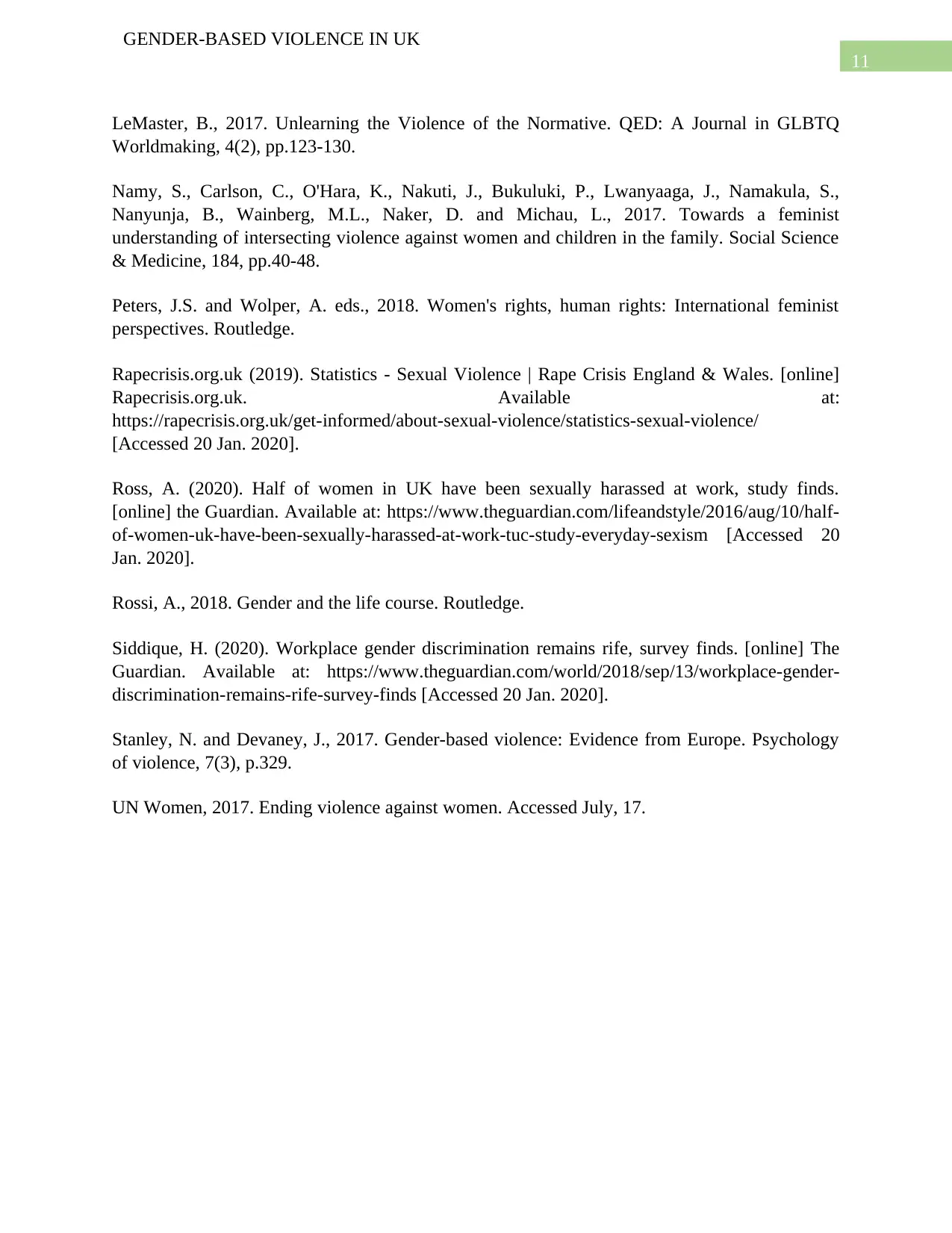
11
GENDER-BASED VIOLENCE IN UK
LeMaster, B., 2017. Unlearning the Violence of the Normative. QED: A Journal in GLBTQ
Worldmaking, 4(2), pp.123-130.
Namy, S., Carlson, C., O'Hara, K., Nakuti, J., Bukuluki, P., Lwanyaaga, J., Namakula, S.,
Nanyunja, B., Wainberg, M.L., Naker, D. and Michau, L., 2017. Towards a feminist
understanding of intersecting violence against women and children in the family. Social Science
& Medicine, 184, pp.40-48.
Peters, J.S. and Wolper, A. eds., 2018. Women's rights, human rights: International feminist
perspectives. Routledge.
Rapecrisis.org.uk (2019). Statistics - Sexual Violence | Rape Crisis England & Wales. [online]
Rapecrisis.org.uk. Available at:
https://rapecrisis.org.uk/get-informed/about-sexual-violence/statistics-sexual-violence/
[Accessed 20 Jan. 2020].
Ross, A. (2020). Half of women in UK have been sexually harassed at work, study finds.
[online] the Guardian. Available at: https://www.theguardian.com/lifeandstyle/2016/aug/10/half-
of-women-uk-have-been-sexually-harassed-at-work-tuc-study-everyday-sexism [Accessed 20
Jan. 2020].
Rossi, A., 2018. Gender and the life course. Routledge.
Siddique, H. (2020). Workplace gender discrimination remains rife, survey finds. [online] The
Guardian. Available at: https://www.theguardian.com/world/2018/sep/13/workplace-gender-
discrimination-remains-rife-survey-finds [Accessed 20 Jan. 2020].
Stanley, N. and Devaney, J., 2017. Gender-based violence: Evidence from Europe. Psychology
of violence, 7(3), p.329.
UN Women, 2017. Ending violence against women. Accessed July, 17.
GENDER-BASED VIOLENCE IN UK
LeMaster, B., 2017. Unlearning the Violence of the Normative. QED: A Journal in GLBTQ
Worldmaking, 4(2), pp.123-130.
Namy, S., Carlson, C., O'Hara, K., Nakuti, J., Bukuluki, P., Lwanyaaga, J., Namakula, S.,
Nanyunja, B., Wainberg, M.L., Naker, D. and Michau, L., 2017. Towards a feminist
understanding of intersecting violence against women and children in the family. Social Science
& Medicine, 184, pp.40-48.
Peters, J.S. and Wolper, A. eds., 2018. Women's rights, human rights: International feminist
perspectives. Routledge.
Rapecrisis.org.uk (2019). Statistics - Sexual Violence | Rape Crisis England & Wales. [online]
Rapecrisis.org.uk. Available at:
https://rapecrisis.org.uk/get-informed/about-sexual-violence/statistics-sexual-violence/
[Accessed 20 Jan. 2020].
Ross, A. (2020). Half of women in UK have been sexually harassed at work, study finds.
[online] the Guardian. Available at: https://www.theguardian.com/lifeandstyle/2016/aug/10/half-
of-women-uk-have-been-sexually-harassed-at-work-tuc-study-everyday-sexism [Accessed 20
Jan. 2020].
Rossi, A., 2018. Gender and the life course. Routledge.
Siddique, H. (2020). Workplace gender discrimination remains rife, survey finds. [online] The
Guardian. Available at: https://www.theguardian.com/world/2018/sep/13/workplace-gender-
discrimination-remains-rife-survey-finds [Accessed 20 Jan. 2020].
Stanley, N. and Devaney, J., 2017. Gender-based violence: Evidence from Europe. Psychology
of violence, 7(3), p.329.
UN Women, 2017. Ending violence against women. Accessed July, 17.
1 out of 12
Related Documents
Your All-in-One AI-Powered Toolkit for Academic Success.
+13062052269
info@desklib.com
Available 24*7 on WhatsApp / Email
![[object Object]](/_next/static/media/star-bottom.7253800d.svg)
Unlock your academic potential
© 2024 | Zucol Services PVT LTD | All rights reserved.




